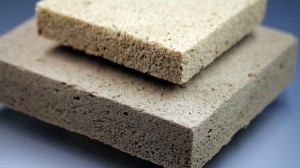Since most foam materials are made of petrochemical plastics, they aren’t very climate-friendly. But now an alternative is in sight – a novel foam material produced entirely from wood. Source: Science Daily
This material is not harmful to the environment and is recyclable.
In the long term, wood foam could replace conventional products used for thermal insulation, packaging, scientists say.
Researchers at the Fraunhofer Institute for Wood Research, Wilhelm-Klauditz-Institut, WKI in Braunschweig have adopted a very promising approach to the problem by developing a method for creating foam from wood particles. “Our wood foam can be used in exactly the same way as conventional plastic foams, but is an entirely natural product made from sustainable raw materials,”
said Professor Volker Thole, department head for process technology and system technology for wood-based materials at Fraunhofer WKI.
Another of its advantages is that, unlike conventional foam products, wood foam can be easily recycled after use.
For instance, if used as packaging material, it can be simply discarded in the paper recycling bin.
The novel material has such great potential that it won a 2015 GreenTec Award in the “Construction and Living” category.
The scientists produce the foam by first grinding wood very finely until the tiny wood particles become a viscous mass.
They then add gas to this suspension to expand it into a frothy foam and allow it to harden.
The hardening process is aided by natural substances contained in the wood itself.
This new manufacturing technique is based on specific chemical processes.
“It’s similar to the way dough rises and sets when bread is baked in an oven,” Thole said.
The resulting wood foam is a lightweight base material that can be formed into rigid boards or flexible sheets.
Just like other wood-based products, they can be easily sawed or cut to the desired dimensions.
Wood foam in home insulation Wood foam is an ideal material for home insulation, where the aim is keep the heat inside and create a cozy environment for the building’s occupants.
Until now, the plastic foam products available have mainly been petrochemical based. The few alternative wood-based insulation materials, such as woodfiber sheets or wood-fiber wool, are less resistant to deformation than foam plastic insulation materials.
“Thin sheets of fiber insulation have a tendency to gradually collapse under their own weight due to the accumulation of moisture, especially in the middle. This adversely affects their insulating properties,” said Thole.
By contrast, the wood foam developed at the WKI is every bit as good as conventional plastic foams in this regard.
“We analyzed our foam products in accordance with the applicable standards for insulation materials and obtained very promising results, not only in terms of their thermal insulation properties but also with respect to their mechanical and hydrodynamic properties,” said Thole.
In other words, the wood foam insulates as well as conventional plastic foams, and is resistant to pressure and humidity.
The Braunschweig-based scientists are currently experimenting with different types of wood to determine which tree species provide the best raw material for this application.
Furthermore, they are working to identify suitable processes for mass-producing wood foams on an industrial scale.
The wood-based foam products are expected to be ready for commercialization within a few years.






